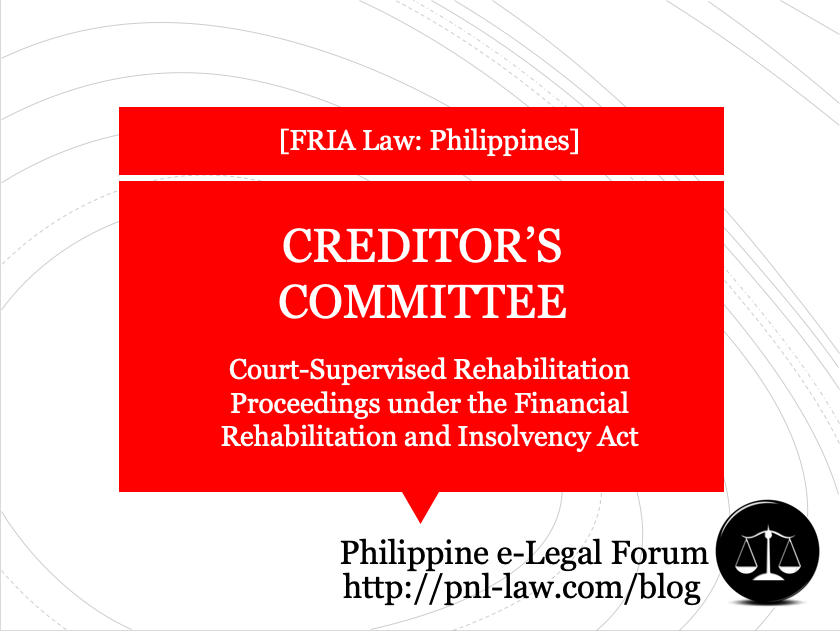After the petition for court-supervised rehabilitation, whether voluntary or involuntary, is given due course, the court shall issue an order directing the rehabilitation receiver to call a meeting with the debtor and all classes of creditors, to take place in not less than 2 weeks nor more than 4 weeks from the date of the order, to consider the organization of a creditors’ committee.

The order shall designate the day, hour and place of the meeting, and shall be published as often as may be prescribed by the court, but in no case less than 2 consecutive weeks, in a newspaper of general circulation in the Philippines, if there be one, and if there be none, in a newspaper which, in the court’s judgment, will best give notice to the creditors of the debtor. The debtor shall be personally notified of this order.
After this meeting is called and held, the creditors belonging to a class may formally organize a committee among themselves. In addition, the creditors may, as a body, agree to form a creditors’ committee composed of a representative from each class of creditors, such as the following:
- 3. trade creditors and suppliers; and
- 4. employees of the debtor.
A creditors’ committee may be organized if the creditors, representing at least a majority of all the claims as reflected in the registry of claims, cast their votes for its creation.
ELECTION OF REPRESENTATIVES TO THE CREDITORS’ COMMITTEE
The creditors from each class shall be entitled to elect their representative to the creditors’ committee. Each creditor shall vote in proportion to his interest vis-a-vis the total claims of all the creditors within the same class as determined by the rehabilitation receiver based on the registry of claims, provided, that such determination shall only be for the purpose of voting under this section and shall not be binding on any creditor as to the nature and amount of its claim.
In case of a juridical creditor, the designated representative bearing the necessary authority shall be entitled to vote.
Voting may be done personally, by mail or by proxy, provided that if a vote is cast through mail or by proxy, the same should be accompanied by the necessary authority to cast the vote for the particular creditor. Voting by electronic mail or means shall be in accordance with the Rules on Electronic Evidence.
ELECTION OF CHAIRMAN OF THE CREDITORS’ COMMITTEE
When the representatives of each class of creditors to the creditors’ committee have been elected, the rehabilitation receiver shall convene the chosen representatives to elect the chairman of the creditors’ committee.
The representative of each class of creditors shall be entitled to cast only 1 vote in the election of the chairman of the creditors’ committee. Any tie shall be resolved by drawing of lots.
The chairman shall then be responsible for convening the creditors’ committee, whenever necessary, to discuss, deliberate, and confer with the rehabilitation receiver, on any view or proposal in the preparation, review or revision of a Rehabilitation Plan for the debtor.
ROLE OF CREDITORS’ COMMITTEE
The creditors’ committee shall be the primary liaison between the rehabilitation receiver and the creditors. The creditors’ committee cannot exercise or waive any right or give any consent on behalf of any creditor unless specifically authorized in writing by such creditor. The creditors’ committee may be authorized by the court or by the rehabilitation receiver to perform such other tasks and functions to facilitate the rehabilitation process.
The creditors’ committee’s act shall be valid if a majority of its members voted, and a majority of the members who have cast their votes have voted in favor of the resolution.
The creditors’ committee, if already constituted, shall be notified of all actions relative to the rehabilitation proceedings; otherwise, the individual creditors shall be so notified by the rehabilitation receiver.
The members of the creditors’ committee shall be entitled to a reasonable fee as compensation, which shall be treated as an administrative expense, subject to the prior determination and approval by the court.
DETERMINATION OF CLASS OF CREDITORS
The rehabilitation receiver shall determine within a reasonable time the class to which each creditor belongs; provided that each creditor shall be given the opportunity to challenge the rehabilitation receiver’s determination of its classification by presenting evidence to prove its claims. Such challenge shall first be brought before the rehabilitation receiver for his reconsideration within 5 days from notice of such determination by the rehabilitation receiver.
Any denial by the rehabilitation receiver of such challenge may be brought to the court within 5 days from notice thereof. The decision of the court on this matter shall be final and executory only insofar as the classification of the said creditor for purposes of representation in the creditors’ committee is concerned but not as to the determination of the nature of its claim.
- Extension of Filing Periods and Suspension of Hearings for March 29 to April 4, 2021: SC Administrative Circular No. 14-2021 (Full Text) - March 28, 2021
- ECQ Bubble for NCR, Bulacan, Cavite, Laguna and Rizal: Resolution No. 106-A (Full Text) - March 27, 2021
- Guidelines on the Administration of COVID-19 Vaccines in the Workplaces (Labor Advisory No. 3) - March 12, 2021
